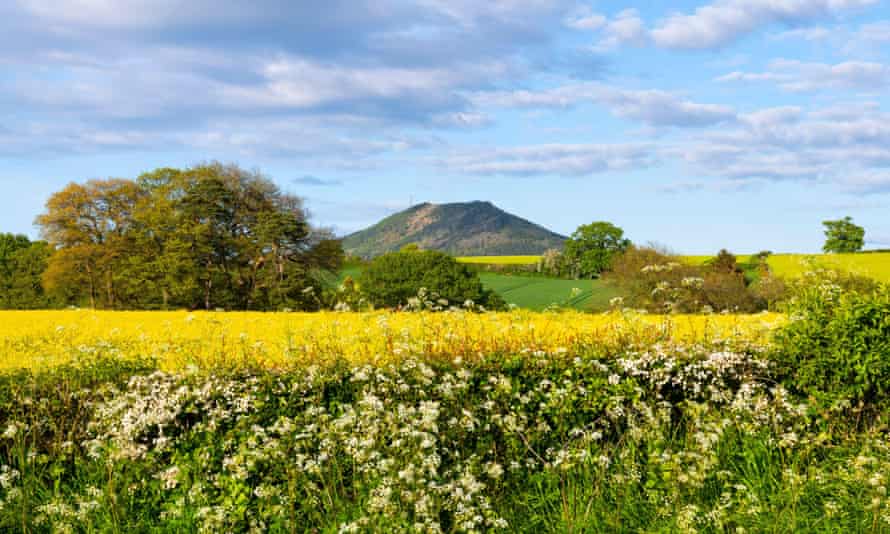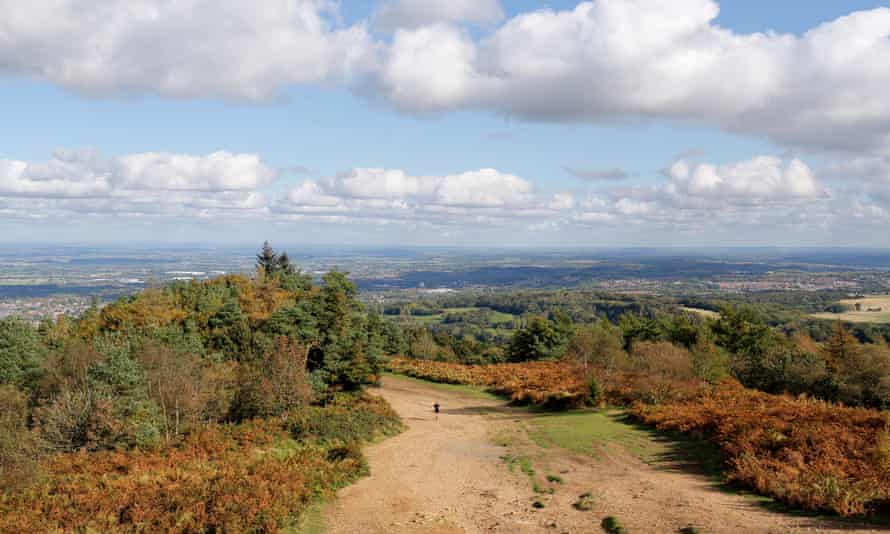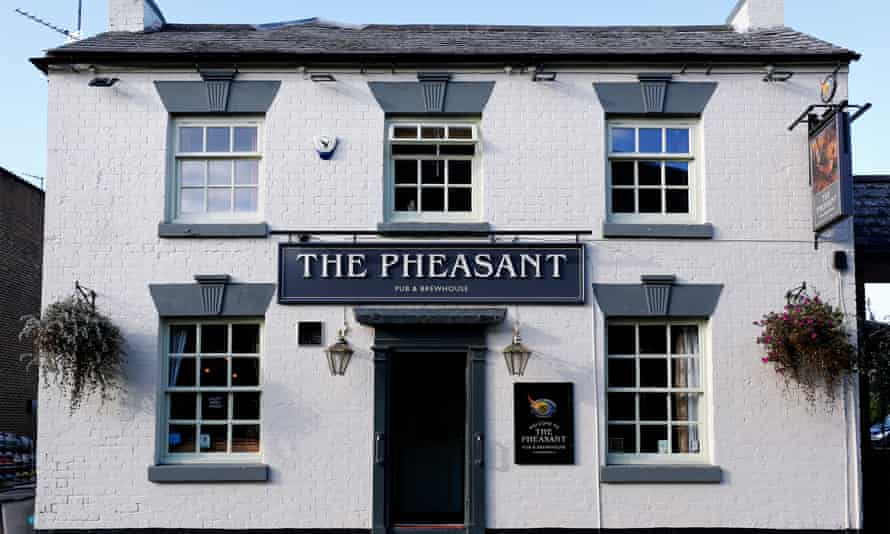Start Forest Glen car park, near Little Wenlock
Distance 4 miles
Time 1½ hours
Total ascent 308 metres
Difficulty Easy to moderate
Google map of the route
Allow Google content?
This article includes content provided by Google. We ask for your permission before anything is loaded, as they may be using cookies and other technologies. To view this content, click ‘Allow and continue’.
The Wrekin is said to have been formed when a giant called Cawr dropped a shovel of earth on the way to Shrewsbury. The name of the clumsy clod is Welsh for giant; Wales is just 30 miles away, and Shrewsbury was routinely the site of skirmishes between the Welsh and whoever happened to have invaded England at the time. The name Wrekin, like nearby Wroxeter, probably derives from Wreocensæte, an Anglo-Saxon kingdom.
Though only 407 metres high, the hill is special to Shropshire because it has, since the days of the industrial revolution, been a place for workers from as far away as the Black Country to find clean air and respite. Deep inside its woods are the remains of medieval charcoal-burning platforms; iron was smelted here long before the iconic Ironbridge was constructed.
The Wrekin is also the only thing for miles around that pops out of the surrounding (slightly misnamed) Cheshire Plain. Its parent peak – the closest other prominence – is Kinder Scout in Derbyshire. But British walkers know size is insignificant: this mini-mountain packs in more history, geology, birdlife and adventure than you’d guess from its girth or altitude.

The clockwise walk from the car park starts with a sharp climb up a wide track, zigzagging to gain height. Here and there narrow paths, presumably used by fell runners, cut through the ferny undergrowth. The main path ascends more gently through woodlands of veteran oak, ash and beech.
As it’s autumn, everything is in flux. Saproxylic and mycorrhizal fungi may not have the romantic ring of snowdrops and bluebells, but they are mysterious, almost magical presences underfoot. The former, produced by dead wood, twigs and leaf litter, provide food for insects, which in turn support birds and bats, while anything left is drawn down to the latter, which absorb and distribute nutrients to their symbiotic friends – plants and trees.
It pays to walk slowly to keep an ear and eye out for small birds scuttling for grubs, berries and seeds, and for woodpeckers overhead. At the least you’ll catch a squirrel rummaging in the leaf-fall, and a raven or raptor riding the thermals that flow off the hill. After about a mile, a sign points up towards Halfway House, which is currently for sale. Long a hunting ground for bears and wolves, the Wrekin was in medieval times a royal forest, with a “hay” (deer enclosure). Halfway House was built in the 18th century as a lodge for hunters of pheasant and partridge, and in the next century was converted into a place of refreshment for walkers.

Now you are higher you’ll begin to catch views of the flat fields below and the distant green hills. Off another broad path that climbs towards the first false summit are two openings known as Hell’s Gate and Heaven’s Gate. These are entrances to the lower and higher sections, respectively, of an iron age hillfort which made use of the hill’s natural outcrops. Javelin heads found nearby suggest the ramparts were occupied by the Romans in the first century AD.
Where boots have worn away the ground, look out for clumps of rhyolite – a volcanic rock that’s pink and purple in colour. The Wrekin itself, though somewhat cone-shaped, is not a volcano, but the lava from the eruption of a distant fiery mountain, when Shropshire was a tropical island. Deep inside the Wrekin are far older rocks, formed at the latitude of the Falkland Islands about 600m years ago.
It’s not all ancient and mystical up here. Just beneath the summit is a transmitting station for TV and radio signals, built partly underground to appease disgruntled locals. If it’s ugly, it doesn’t detract too much, as just a hop and skip away is the final summit and terrific views of the Shropshire Hills, Malvern Hills, various Welsh massifs, Shrewsbury and Telford. Depending on the haze and the weather, you can see as far as Liverpool, the Pennines and Snowdonia. A handy plaque names the nearby mountains, though I was approached by an even handier, and very friendly, local walker who pointed out Caer Caradoc and the more famous – and shapely – Long Mynd.

Stepping through a cleft on the summit known as the Needle’s Eye is said to be an important rite of passage for a “true Salopian” (I’m not sure if that means a local rustic or a posh kid at Shrewsbury public school) and a good omen for marriage.
The descent from the summit is steep and, on wet days, slippery; tree roots don’t help matters. Some prefer to descend the way they came but I would persevere, as the reward at the foot is a flat path through lovely oak woods. If dusk is descending, listen out for tawny owls and take a look at the skies before you leave: the Wrekin is a designated Dark Sky Discovery site with a “Milky Way rating” – which means good access and no need of binoculars to see the heavenly glories.
The walk can easily be made longer (eight miles) with a loop around Ercall, a lower tump north-east of the Wrekin. It’s around half an hour’s walk to Wellington and the Pheasant pub. If you can handle 13 miles, you can walk to your room for the night on the Shropshire Way. OS Explorer maps 241 and 242 cover the area. Wellington station is 40 minutes’ walk from the foot of the Wrekin. Bus X4 from Telford goes slightly closer, to Holyhead Road.
The pub

There must be five foodie pubs for every old-school boozer, even in the fairly working-class Telford area. Still, within half an hour’s walk or 5-10 minutes’ drive from the Wrekin are half a dozen honest pubs. The Pheasant, on Market Street, is a tap house for Rowton Brewery, at the back, which makes quaffable session bitters, pale ales, stout and – wonders will never cease – a mild. The pub has a logburner and lots of wood furniture and panelling, which generates that warm, beer-tinted glow that suits a glass of real ale. Baps, pork pies and ploughmans’ lunches are served, and there are occasional live music gigs and fundraisers. Dogs are welcome.
Where to stay
The Haughmond is a former 17th-century coaching inn run by wife-and-husband team Mel and Martin Board, in the tiny village of Upton Magna. Rooms are named after deer species, a nod to nearby Attingham Park, and animal pictures adorn the walls. Stylish rooms have oak furniture, white linen, shower and bath and – from most – a great view of the Wrekin. Martin is a gifted chef: hake in beurre blanc is meaty and crisp; ox tongue hash is rich and rude; and there are tasting menus for omnivores and vegetarians. What has cemented the inn’s status as more than a local “restaurant with rooms” is the well-stocked deli-cum-store that supplies villagers, walkers and cyclists with milk, bread, fresh produce, snacks and cooked breakfasts. Doubles from £95 B&B, thehaughmond.co.uk




